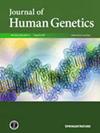白俄罗斯东南部线粒体基因库的异质性。
IF 2.5
3区 生物学
Q2 GENETICS & HEREDITY
引用次数: 0
摘要
线粒体DNA (mtDNA)变异在全有丝分裂基因组水平上的研究对人类进化和群体遗传学具有重要意义。在本文中,我们提出了一项研究的结果,在白俄罗斯共和国东南部的白俄罗斯人完整的mtDNA变异性。研究发现,东南白俄罗斯人的线粒体基因组具有高度多样性。对欧洲人群之间遗传距离的分析显示,所研究的白俄罗斯人样本与包括斯拉夫民族在内的大部分东欧人群之间存在显著差异。系统地理分析结果表明,白俄罗斯人线粒体基因库中存在西亚成分(12.6%),这可以解释白俄罗斯人和其他东斯拉夫人(俄罗斯人和乌克兰人)之间观察到的遗传差异。白俄罗斯人研究组线粒体基因库的东亚部分由单倍群C5c1a(2.3%)代表。系统地理分析结果表明,该mtDNA亚支主要存在于包括波兰人、白俄罗斯人、乌克兰人和俄罗斯人在内的斯拉夫民族的基因库中。单倍型群C5c1a的进化年龄约为4000年,因此,c5c1单倍型在欧洲东部地区的出现可能与青铜时代里海草原种群向西迁移有关。本文章由计算机程序翻译,如有差异,请以英文原文为准。

Heterogeneity of the Southeast Belarusian mitochondrial gene pool
The study of mitochondrial DNA (mtDNA) variability at the level of whole mitogenomes has significant implications for the fields of human evolution and population genetics. In this paper, we present the results of a study of the complete mtDNA variability in Belarusians from the southeastern part of the Republic of Belarus. It was found that Southeast Belarusians are characterized by a high diversity of mitochondrial genomes. The analysis of genetic distances between European populations showed significant differences between the studied Belarusian sample from the bulk of East European populations, including Slavic ethnic groups. The results of the phylogeographic analysis indicated the presence of the West Asian component (12.6%) in the Belarusian mitochondrial gene pool, which can account for the observed genetic differences between Belarusians and other Eastern Slavs (Russians and Ukrainians). The East Asian component of the mitochondrial gene pool of the studied group of Belarusians is represented by haplogroup C5c1a (2.3%). The results of the phylogeographic analysis indicated that this mtDNA subclade is predominantly present in the gene pools of Slavic peoples, including Poles, Belarusians, Ukrainians, and Russians. The evolutionary age of haplogroup C5c1a is ~4000 years and, consequently, the appearance of C5c1-haplotypes in the eastern regions of Europe may be linked to the migrations of the Caspian steppe populations to the west during the Bronze Age.
求助全文
通过发布文献求助,成功后即可免费获取论文全文。
去求助
来源期刊

Journal of Human Genetics
生物-遗传学
CiteScore
7.20
自引率
0.00%
发文量
101
审稿时长
4-8 weeks
期刊介绍:
The Journal of Human Genetics is an international journal publishing articles on human genetics, including medical genetics and human genome analysis. It covers all aspects of human genetics, including molecular genetics, clinical genetics, behavioral genetics, immunogenetics, pharmacogenomics, population genetics, functional genomics, epigenetics, genetic counseling and gene therapy.
Articles on the following areas are especially welcome: genetic factors of monogenic and complex disorders, genome-wide association studies, genetic epidemiology, cancer genetics, personal genomics, genotype-phenotype relationships and genome diversity.
 求助内容:
求助内容: 应助结果提醒方式:
应助结果提醒方式:


